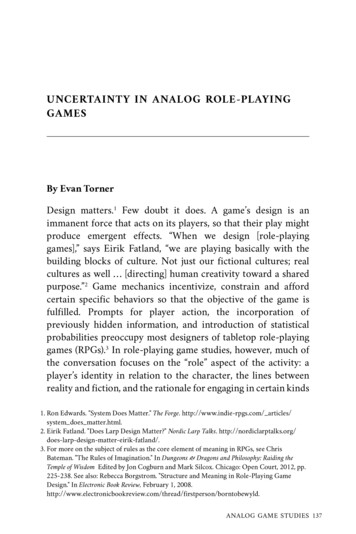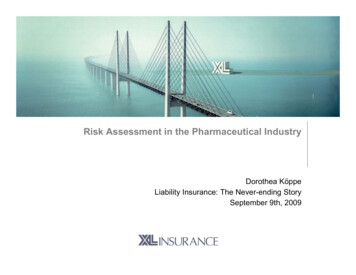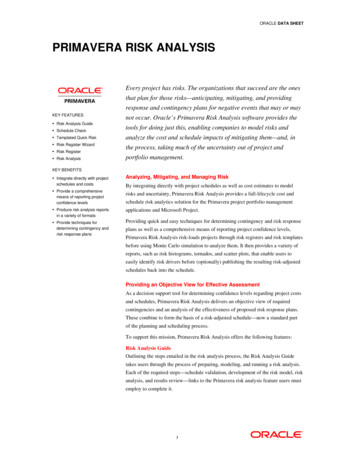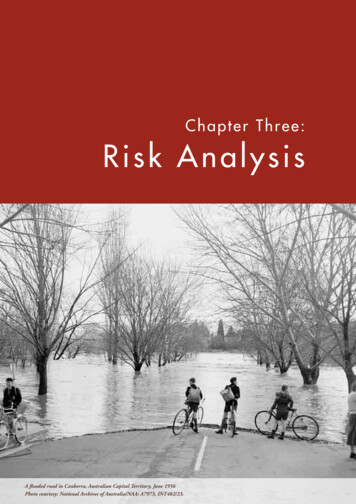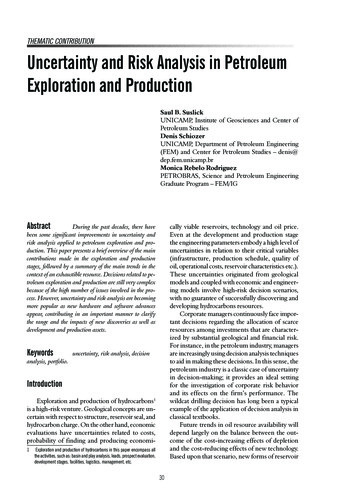
Transcription
Suslick,S.B., Schiozer,D., Rodriguez, M.R.THEMATICCONTRIBUTIONTERRÆ 6(1):30-41, 2009Uncertainty and Risk Analysis in PetroleumExploration and ProductionSaul B. SuslickUNICAMP, Institute of Geosciences and Center ofPetroleum StudiesDenis SchiozerUNICAMP, Department of Petroleum Engineering(FEM) and Center for Petroleum Studies – denis@dep.fem.unicamp.brMonica Rebelo RodriguezPETROBRAS, Science and Petroleum EngineeringGraduate Program – FEM/IGAbstractDuring the past decades, there havebeen some significant improvements in uncertainty andrisk analysis applied to petroleum exploration and production. This paper presents a brief overview of the maincontributions made in the exploration and productionstages, followed by a summary of the main trends in thecontext of an exhaustible resource. Decisions related to petroleum exploration and production are still very complexbecause of the high number of issues involved in the process. However, uncertainty and risk analysis are becomingmore popular as new hardware and software advancesappear, contributing in an important manner to clarifythe range and the impacts of new discoveries as well asdevelopment and production assets.Keywordscally viable reservoirs, technology and oil price.Even at the development and production stagethe engineering parameters embody a high level ofuncertainties in relation to their critical variables(infrastructure, production schedule, quality ofoil, operational costs, reservoir characteristics etc.).These uncertainties originated from geologicalmodels and coupled with economic and engineering models involve high-risk decision scenarios,with no guarantee of successfully discovering anddeveloping hydrocarbons resources.Corporate managers continuously face important decisions regarding the allocation of scarceresources among investments that are characterized by substantial geological and financial risk.For instance, in the petroleum industry, managersare increasingly using decision analysis techniquesto aid in making these decisions. In this sense, thepetroleum industry is a classic case of uncertaintyin decision-making; it provides an ideal settingfor the investigation of corporate risk behaviorand its effects on the firm’s performance. Thewildcat drilling decision has long been a typicalexample of the application of decision analysis inclassical textbooks.Future trends in oil resource availability willdepend largely on the balance between the outcome of the cost-increasing effects of depletionand the cost-reducing effects of new technology.Based upon that scenario, new forms of reservoiruncertainty, risk analysis, decisionanalysis, portfolio.IntroductionExploration and production of hydrocarbons1is a high-risk venture. Geological concepts are uncertain with respect to structure, reservoir seal, andhydrocarbon charge. On the other hand, economicevaluations have uncertainties related to costs,probability of finding and producing economi1Exploration and production of hydrocarbons in this paper encompass allthe activities, such as: basin and play analysis, leads, prospect evaluation,development stages, facilities, logistics, management, etc.30
TERRÆ 6(1):30-41, 2009Suslick, S.B., Schiozer, D., Rodriguez, M.R.pricing and resource allocation in large monopolistic enterprises. Allais’ work was a useful means orpreview to demonstrate Monte Carlo methods ofcomputer simulation and how they might be usedto perform complex probability analysis, instead ofsimplifications of risk estimation of large areas.During this period, there were several attemptsto define resource level probabilities at various stages of exploration in a basin using resource distribution and risk analysis (Kaufman, 1963; Krumbeinand Graybill, 1965; Drew, 1967; Harbaugh et al.,1977; Harris, 1984; Harbaugh, 1984, Harris 1990).At that time governmental agencies (U.S. Geological Survey, Institut Français du Pétrole, etc.) werealso beginning to employ risk analysis in periodicappraisals of oil and gas resources (Figure 1).During the 1980’s and 1990’s, new statisticalmethods were applied using several risk estimationtechniques such as: (1) lognormal risk resourcedistribution (Attanasi and Drew, 1985), (2) Paretodistribution applied to petroleum field-size datain a play (Crovelli, 1995) and (3) fractal normalpercentage (Crovelli et al., 1997). Recently, USGShas developed several mathematical models forundiscovered petroleum resource assessment (Ahlbrandt and Klett, 2005) and forecast reserve growthof fields both in the United States (U.S.) and theworld (Klett, 2005).Throughout 1960’s, the concepts of risk analysis methods were more restricted to academia andwere quite new to the petroleum industry whencontributions appeared from Grayson (1960), Arpsand Arps (1974), Newendorp (1975, edited as Newendorp and Schuyler, 2000) and Megill (1977).Newendorp (op.cit.) emphasized that decisionanalysis does not eliminate or reduce risk and willnot replace professional judgment of geoscientists,engineers, and managers. Thus, one objective ofdecision analysis methods, as will be discussed laterin this paper, is to provide a strategy to minimizethe exposure of petroleum projects to risk and uncertainty in petroleum exploration ventures.The assessment to risk model preferences ofdecision makers can be achieved using a utilityfunction provided by Utility Theory. If companiesmake their decisions rationally and consistently,then their implied risk behaviors can be describedby the parameters of a utility function. DespiteBernoulli’s attempt in the 18th century to quantifyan individual’s financial preferences, the parameters of the utility function were formalized onlyexploitation and management will appear wherethe contributions of risk and decision models areone of the important ingredients. This trend canbe seen in the last two decades. The new internationally focused exploration and productionstrategies were driven in part by rapidly evolvingnew technologies. Technological advances allowedexploration in well-established basins as well asin new frontier zones such as ultra-deep water.Those technology-driven international exploration and production strategies combined with newand unique strategic elements where risk analysisand decision models represent important components of a series of investment decisions.This paper covers a brief review of previousapplications involving the following topics: (1)Risk and Decision Analysis in Petroleum Exploration; (2) Field Appraisal and Development, andUncertainty in Production Forecasts, (3) the Decision Making Process and Value of Informationand (4) Portfolio Management and Valuation Option Approach. This paper describes some of themain trends and challenges and presents a discussion of methodologies that affect the present levelof risk applied to the petroleum industry aimed atimproving the decision-making process.Risk Analysis: ExplorationThe historical origins of decision analysis canbe partially traced to mathematical studies of probabilities in the 17th and 18th centuries by Pascal,Laplace, and Bernoulli. However, the applicationsof these concepts in business and general management appeared only after the Second WorldWar (Covello and Mumpower, 1985; Bernstein,1996). The problem involving decision-makingwhen there are conditions of risk and uncertaintyhas been notorious since the beginnings of theoil industry. Early attempts to define risk wereinformal.The study by Allais (1956) on the economicfeasibility of exploring the Algerian Sahara is a classic example because it is the first study in which theeconomics and risk of exploration were formallyanalyzed through the use of the probability theoryand an explicit modeling of the sequential stagesof exploration. Allais was a French economist whowas awarded the Nobel Prize in Economics in 1988for his development of principles to guide efficient31
Proved ProbableContigentResourcesLowEstimateProved Probable PossibleHighEstimateBestEstimateProject MaturityCommercialSub-commercialDiscovered veredPetroleumIniatially-inPlaceTotal Petroleum - Iniatially in PlaceProductionstatuct topmlevDectspeProLowRiskTERRÆ 6(1):30-41, 2009HighRiskSuslick, S.B., Schiozer, D., Rodriguez, BestEstimateyPlaUnrecoverableRange of UncertaintyFigure 1 – Petroleum Resource Classification Scheme (modified from Ross, 2004 and SPE/WPC/AAPG, 2000)300 hundred years later by von Neumann andMorgenstern (1953) in modern Utility Theory.This seminal work resulted in a theory specifyinghow rational individuals should make decisionsin uncertain conditions. The theory includes a setof axioms of rationality that form the theoreticalbasis of decision analysis. Descriptions of this fullset of axioms and detailed explanations of decisiontheory are found in Savage (1954), Pratt (1964), andSchailfer (1969). Cozzolino (1977) used an exponential utility function in petroleum exploration toexpress the certainty equivalent that is equal to theexpected value minus a risk discount, known as therisk premium. Acceptance of the exponential formof risk aversion leads to the characterization of riskpreference (risk aversion coefficient), which measures the curvature of the utility function. Lercheand MacKay (1999) showed a more comprehensible form of risk tolerance that could intuitivelybe seen as the threshold value, whose anticipatedloss is unacceptable to the decision maker or tothe corporation.An important contribution that provides richinsight into the effects of integrating corporate ob-jectives and risk policy into the investment choiceswas made by Walls (1995) for oil and gas companies using the multi-attribute utility methodology(MAUT). Walls and Dyer (1996) employed theMAUT approach to investigate changes in corporate risk propensity with respect to changes in firmsize in the petroleum industry. Nepomuceno Fo etal. (1999) and Suslick and Furtado (2001) appliedthe MAUT models to measure technological progress, environmental constraints as well as financialperformance associated with exploration and production projects located in offshore deep waters.More recently, several contributions devisepetroleum exploration consisting of a series ofinvestment decisions on whether to acquire additional technical data or additional petroleum assets(Rose, 1987). Based upon these premises exploration could be seen as a series of investment decisions made under decreasing uncertainty whereevery exploration decision involves considerationsof both risk and uncertainty (Rose, 1992). Theseaspects lead to a substantial variation in what ismeant by risk and uncertainty. Some authors suchas Knight (1921) make a distinction between risk32
TERRÆ 6(1):30-41, 2009Suslick, S.B., Schiozer, D., Rodriguez, M.R.(where probabilities are known) and uncertainty(where one is unable to assign probabilities) focusing their analysis on uncertainty. Meanwhile,Megil (1977) considered risk an opportunity forloss. Risk considerations involve size of investmentwith regard to budget, potential gain or loss, andprobability of outcome. Uncertainty refers to therange of probabilities in which some conditionsmay exist or occur.Rose (2001) pointed out that each decisionshould allow a progressively clearer perception ofproject risk and exploration performance that canbe improved through a constructive analysis of geotechnical predictions, review of exploration tacticsversus declared strategy, and year-to-year comparison of exploration performance parameters. Thesefindings showed the importance of assessing therisk behavior of firms and managerial risk attitudes.Continued monitoring of the firm’s level of riskaversion is necessary due to the changing corporateand industry environment as well as the enormouscontribution generated by technological development in E&P. Over any given budgetary period,utilization of an established risk aversion level willresult in consistent and improved decision makingwith respect to risk.without significant precision loss. Simplificationsare possible, for instance, in the modeling tool,treatment of attributes and in the way several typesof uncertainties are integrated.One of the simplest approaches is to work withthe recovery factor (RF) that can be obtained fromanalytical procedures, empirical correlations or previous simulation runs, as presented by Salomão andGrell (2001). When higher precision is necessary, orwhen the rate of recovery significantly affects theeconomic evaluation of the field, using only theexpected recovery factor may not be sufficient.Techniques such as experimental design, response surface methods and proxy models havebeen used by several authors (Damsleth et al., 1991;Dejean, 1999; Ligero et al., 2007) in order to accelerate the process. Another possible approach is touse faster models such as a streamline simulation ora fast coarse grid simulation as proposed by Hastings et al. (2001), Ballin et al. (1993), Subbey andChristie (2003), and Ligero et al. (2003).The integration of risk analysis into the definition of production strategy can also be very timeconsuming because several alternatives are possibleand restrictions have to be considered. Alternativesmay vary significantly according to the possible scenarios. Schiozer et al. (2004) proposed an approachto integrate geological and economic uncertaintieswith production strategy using geological representative models to avoid large computational effort.Integration is necessary in order to (1) quantify the impact of decisions on the risk of theprojects, (2) calculate the value of information, asproposed by Demirmen (2001) and (3) quantifythe value of flexibility (Begg and Bratvold, 2002;Hayashi et al., 2007). The understanding of theseconcepts is important to correctly investigate thebest way to perform risk mitigation and to addvalue to E&P projects.Therefore, risk analysis applied to the appraisal and development phase is a complex issue and it is no longer sufficient to quantify risk.Techniques today are pointing to: (1) quantification of value of information and flexibility, (2)optimization of production under uncertainty,(3) mitigation of risk and (4) treatment of riskas an opportunity. All these issues are becomingpossible due to hardware and software advances,allowing an increasing number of simulationruns of reservoir models with higher complexity(Gorell and Basset, 2001).Risk Analysis: Field Appraisal and DevelopmentDuring the exploration phase, major uncertainties are related to volumes in place and economics.As the level of information increases, these uncertainties are mitigated and, consequently, the importance of the uncertainties related to technologyand recovery factor increases. The situation is morecritical in offshore fields and for heavy-oil reservoirs, where investments are higher and there is alower operational flexibility (Pinto et al., 2001).In the preparation of development plans, fieldmanagement decisions are complex issues becauseof (1) the number and type of decisions, (2) thegreat effort required to predict production withthe necessary accuracy and (3) the dependency ofproduction strategy definition on several types ofuncertainty with significant impact on risk quantification.In order to avoid excessive computation effort,some simplifications are always necessary. The keypoint is to define the simplifications and assumptions that can be made to improve performance33
Suslick, S.B., Schiozer, D., Rodriguez, M.R.TERRÆ 6(1):30-41, 2009Decision Making Process, Value of Information and Flexibilityexpected benefit greater than the cost of information. The information is seldom perfectly reliableand generally it does not eliminate uncertainty,so the value of information depends on both theamount of uncertainty (or the prior knowledgeavailable) and payoffs involved in E&P projects.The value of information can be determined andcompared to its actual cost and the natural path toevaluate the incorporation of this new data is byBayesian analysis.As the level of information increases, the decision making process becomes more complexbecause of the need for (1) more accurate prediction of field performance and (2) integration withproduction strategy. At this point, the concept ofValue of Information (VoI) must be integrated withthe Value of Flexibility (VoF) as shown by Hayashiet al. (2007). Therefore, risk may be mitigated bymore information or flexibility in the production strategy definition. Reservoir developmentby stages and smart wells are good examples ofinvestments in flexibility. The decision to investin information or flexibility is becoming easier asmore robust methodologies to quantify VoI andVoF are developed.Making important decisions in the petroleumindustry requires incorporation of major uncertainties, long time horizons, multiple alternatives,and complex value issues into the decision model.Decision analysis can be defined on differentand embedded levels in petroleum explorationand production stages. Raiffa (1968) and Keeney(1982) defined decision analysis as a philosophy,articulated by a set of logical axioms, and a methodology and collection of systematic procedures,based upon those axioms, for responsibly analyzingthe complexities inherent in decision problems.Several textbooks can be found in Raiffa, 1968;Keeney, 1982; Keeney and Raifa, 1976; Howard,1988; Kirkwood, 1996, and Clemen, 1990. In thelast two decades, the theoretical and methodological literature on various aspects of decision analysishas grown substantially in many areas of petroleumsector, especially in applications involving health,safety, and environmental risk.Many complex E&P decision problems involvemultiple conflicting objectives. Under these circumstances, managers have a growing need to employ improved and systematic decision processesthat explicitly embody the firm’s objectives, desiredgoals, and resource constraints. Over the last twodecades, the advances in computer-aided decisionmaking processes have provided a mechanism toimprove the quality of decision making in the modern petroleum industry. Walls (1996) developeda decision support model that combines toolboxsystem components to provide a comprehensiveapproach to petroleum exploration planning fromgeological development through the capital allocation process.An effective way to express uncertainty isto formulate a range of values, with confidencelevels assigned to numbers comprising the range.Although geoscientists and engineers may bewilling to make predictions about unknown E&Psituations, there is a need to assess the level ofuncertainty of the projects. So, it’s necessary todefine the value of information associated withimportant decisions such as deferring drilling of ageologic prospect or seismic survey. Informationonly has value in a decision problem if it results ina change in some action to be taken by a decisionmaker. Furthermore, this change must bring anRisk Mitigation through History MatchingThe integration of risk analysis and productionhistory matching is also a subject that has recentlybeen receiving special attention (Schiozer et al.,2005; Maschio et al., 2005; Suzuki and Caers, 2006;MA et al., 2006; Kashib and Srinivasan, 2006).The general idea is to integrate the processes ofreservoir development when uncertainties existand the reservoir management process in order tomitigate risk gradually as production is observedand used to reduce uncertainties in geologic attributes. This type of procedure has a great potentialof improvement as new tools are being developedto speed up the process, which requires high computational effort.Portfolio Management and the Real OptionsValuationsAsset managers in the oil and gas industryare looking to new techniques such as portfoliomanagement to determine the optimum diversi34
TERRÆ 6(1):30-41, 2009Suslick, S.B., Schiozer, D., Rodriguez, M.R.fied portfolio that will increase company valueand reduce risk. Under this approach employedextensively in financial markets, projects are selected based upon quantitative information on theircontribution to the company’s long-term strategyand how they interact with the other projects in theportfolio. The financial market and efficient portfolio theory was proposed by Markowitz (1952),winner of the 1990 Nobel Prize in Economics.This work has been adapted for the petroleumindustry. A portfolio is said to be efficient if noother portfolio has more value while having lessor equal risk, and if no other portfolio has less riskwhile having equal or greater value. The mostimportant principle in portfolio analysis theory isthat the emphasis must be placed on the interplayamong the projects (Ball and Savage, 1999). Theoriginal idea states that a portfolio can be worthmore or less than the sum of its component projectsand there is not one best portfolio, but a family ofoptimal portfolios that achieve a balance betweenrisk and value.As the number of project opportunities grows,the petroleum industry is faced with an increasinglydifficult task in selecting an ideal set of portfolios.Figure 2 pointed out the complexity of integrationof geological, engineering, economic, and fiscalmodeling - all in the context of the firm’s strategicobjectives.Mathematical search and optimization algorithms can greatly simplify the planning process.A particularly well-suited class of algorithms hasbeen developed recently for oil and gas applications in portfolio management (Davidson andDavies, 1995; Chorn and Croft, 1998; Orman andDuggan, 1998; Fichter, 2000; Back, 2001; Erdogan and Mudford, 2001; Garcia and Holtz, 2003).Combined optimal portfolio management withprobabilistic risk-analysis methodology are thushelping to guide managers in evaluating a portfolioof E&P projects, not just according to their value,but also by their inherent risk. Knowing the firm’sattitude about taking financial risk is important interms of selecting the appropriate portfolio of activities. These linkages between decision analysisand portfolio management can improve the overalldecision process, and ultimately, firm performanceas pointed out by Walls (2004). Ross (2004) provided a better characterization of a portfolio of oiland gas assets using a consistent definition of riskand uncertainty, combined with resource classifi-cation based on a clear distinction between projectmaturity and volumetric uncertainties.CapitalAllocationCorporateStrategies micForecastsFigure 2 – Integrated decision process and portfoliooptimization for E&P projectsFor several decades in the petroleum industry,the most common form of asset valuation has beenthe standard discounted cash-flow (DCF) analysis(Figure 3). However, over the past few years, anincreasing number of institutions and organizationshave been experimenting with other valuation approaches to overcome some limitations imposedby the DCF approach. The real options approachis appealing because exploration and productionof hydrocarbons typically involve several decisionstages, each one with an investment schedule andwith associated success and failure probabilities.For example, in the exploration phase the projectcan be viewed as an infinitely compounded optionthat may be continuously exercised as the exploration investment is undertaken. Traditional methodsbased upon discounted cash flow, reported in thefinance literature, are always supported by staticassumptions – no mention about the value of embodied managerial options. Kester (1984) was thefirst to recognize the value of this flexibility. Masonand Merton (1985), and Myers (1987), among others, suggested the use of option-based techniquesto value implicit managerial flexibility in investment opportunities, such as those of abandonmentreactivation, mothballing and timing.35
Suslick, S.B., Schiozer, D., Rodriguez, M.R.TERRÆ 6(1):30-41, 2009Some important earlier real options modelsin natural resources include Tourinho (1979),first to evaluate oil reserves using option-pricingtechniques. Brennan and Schwartz (1985) appliedoption techniques to evaluate irreversible naturalresource assets and McDonald and Siegel (1985) developed similar concepts for managerial flexibility.An important aspect of the majority of explorationand production projects is the value of waiting untilnew options may emerged (i.e., technology, price,cost reduction) has been modeling by McDonaldand Siegel (1986). After real options theory becamewidely accepted in financial markets, applicationsin the oil industry followed rapidly. Siegel et al.(1987) and Paddock et al. (1988) evaluated offshoreoil leases. By the mid 1990’s, several textbooks hadbeen published (Dixit and Pindyck, 1994; Trigeorgis, 1996; and Luenberger, 1998) and the range ofapplications had widened to include applicationsin several economic sectors. Bjerksund and Ekern(1990) showed that it is possible to ignore bothtemporary stopping and abandonment options inthe presence of the option to delay the investmentfor initial oilfield development purposes. Galli etal. (1999) discussed real options, decision-tree andMonte Carlo simulation in petroleum applications.Laughton (1998) found that although oil prospectvalue increases with both oil price and reserve sizeuncertainties, oil price uncertainty delays all option exercises (from exploration to abandonment),whereas exploration and delineation occur soonerwith reserve size uncertainty. Chorn and Croft(2000) studied the value of reservoir information.Armstrong et al. (2004) developed a type ofBayesian analysis and coupled it with real optionstheory to address the question of how to evaluatethe option to acquire more information. The results applied in the case of an oil company that hasthe option to gather information from the production logging tool before carrying out a workover,for example, showed that the value of the optionwas less under conditions of high oil prices thanfor lower oil prices. Dias (2004) presented a set ofselected real options models to evaluate investments in oil exploration and production undermarket and technical uncertainties. In his paper,the author summarized the classical model ofPaddock, Siegel and Smith that exploits a simpleanalogy between American call options and realoptions model for oilfield development.Pre-developmentcostsDevelopment PhaseCASH FLOW( )Farm-in ornew area Acquisitionacquisition CommercialDiscoveryDevelopmentPlan approvalEconomic BoundPRODUCTIONREVENUESeismicPROFITFEE, TAXES,ROYALTIES, n Wells, additional seismic, development planEvaluation Work (drilling, logging, coring, formation tests, etc)Figure 3 – A typical E&P cash-flow project based upon the Brazil Fiscal System (Suslick, 2005)36
TERRÆ 6(1):30-41, 2009Suslick, S.B., Schiozer, D., Rodriguez, M.R.In oil project valuation and investment decision-making, volatility is a key parameter, but it isdifficult to estimate. From a traditional investmentviewpoint, volatility reduces project value becauseit increases its discount rate via a higher risk premium. Contrarily, according to the real-optionpricing theory, volatility may aggregate value tothe project, since the downside potential is limitedwhereas the upside is theoretically unbounded.Costa Lima and Suslick (2006) suggest an alternative numerical method based on present value offuture cash flows and Monte Carlo simulation toestimate the volatility of projects. Results obtainedindicate that commodity volatility usually undervalues that of the project. For the set of offshoreprojects analyzed by the authors, project volatilityis at least 79% higher than that of oil prices andincreases dramatically in those cases of high capitalexpenditures and low price.in corporate culture, operating values and tactics,and the reward system.Risk analysis has several limitations, pitfallsand practical difficulties that affect its value as adecision tool. In some cases, these limitations aredue less to inherent limitations in decision analysisthan to deficiencies in specific applications of theapproach in upstream petroleum projects. There isa need to understand how most effectively to modelproject level risks, whether they are those that affectoutput possibilities or those that directly influencecosts. At the same time, this trend generates a needto fine-tune risk analysis methods by finding outhow to use more discretization without intolerableloss of accuracy yielding a search for a next generation of tools for more complex simulation models.These developments will stimulate new progressas better models and methods make the analyticaltools more flexible and accurate, and thus moreattractive. This will increase the demand for thedevelopment of better risk and decision analysissoftware and training tools, the development ofwhich will make the analyses more attractive andwill encourage the development of better modelsand methods.Most of the methodologies described in this paper are applied to geological and economic uncertainties which are the most important parameters ofthe process; however, there is still need for researchon dealing with operational and technology uncertainties and also for better reservoir characterizationprocedures when uncertainties exist.Despite these limitations and difficulties, riskanalysis has several major strengths and achievements in petroleum exploration and production,as has been shown in this paper. First, risk analysisprovides a means for handling highly complex decisions characterized by multiple objectives and highdegrees of uncertainty in diverse stages of petroleum upstream. Second, risk analysis provides anapproach for dealing with complex value tradeoffand preferences of the stakeholders in the decisionprocess in oil
oil industry. Early attempts to define risk were informal. The study by Allais (1956) on the economic feasibility of exploring the Algerian Sahara is a clas-sic example because it is the first study in which the economics and risk of exploration were fo


